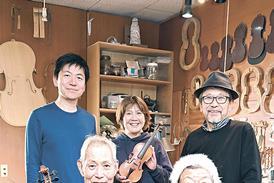Four luthiers and restorers advise a musician on how to care for her instrument during the hot summer months. From August 2014

This article was published in the August 2014 issue of The Strad
Discover more lutherie articles here
The dilemma My viola has just about survived a harsh winter, but now it looks as though we’re in for a long hot summer as well. What’s the best way for me to take care of my instrument in the heat? And are there any tell-tale signs I should look for, which might mean I should get it examined by a repairer?
CHRISTIAN SCHABBON Winter presents us with a relatively dry environment that can lead to shrinking plates and the danger of cracks developing. Summer can also be challenging in certain parts of the world because of excessive heat and humidity, although the probability of the top and back developing cracks is lower than in winter.
Too much humidity can weaken glue joints and soften the wood, making the instrument susceptible to permanent deformation. The neck becomes prone to bending, which can lead to decreased neck projection, with seemingly raised strings, and a depression in the fingerboard.
The neck projection can drop because of the expanding plates, although this is mainly a problem for cellos. Pegs can swell up so much that they cannot be turned any more. Severely swollen pegs can even cause a pegbox crack.
All this damage could require expensive repair, but it is easily preventable. One effective countermeasure is to check the air humidity with a reliable hygrometer. Air conditioning might dry the air sufficiently, but ideally a dehumidifier should be used. The cost of either a humidifier or a dehumidifier will usually be only a small fraction of the repair cost for a damaged instrument.
Take the viola to a restorer if you notice any buzzing or a major change in sound, since these might indicate an open seam, an unglued joint or simply the need for a small sound adjustment. Also have it checked if the strings feel unusually high, or if the pegs are jammed.
Christian Schabbon is a graduate of the Civic School of Violin Making in Milan, Italy. He now works as a restorer at Reuning and Son Violins in Boston, US.
ANTOINE LESPETS The problem with hot summers is the transition between the air-conditioned environment inside and the heat outside. Our little wooden companions don’t like the change. The instrument can adapt to hot, cold, dry or humid conditions but what is more difficult is the period of variation. The wood expands or swells in humid conditions and contracts or shrinks in dry conditions, and the glue used for centuries to make and restore instruments is made out of nerves or bones dissolved in hot water. The fact that it can come unstuck is a good thing in that it allows for restorations, but also a bad thing in that it loses its gripping power under warm and humid conditions.
Modern instrument cases are well insulated and pretty good at slowing down the change in condition as musicians travel from one place to another. Nowadays we can also insert a humidifier into the case to slow down the process even more. Of course, varnish should never be exposed to direct sunlight for too long: the heat could melt it and create bubbles that are very hard to repair.
You will need to see a violin maker if you spot a seam or a crack that has come unglued, or if the string height and action change. For instance, the neck angle often drops a bit when an instrument comes to Australia because of our hot and humid climate. It is also a good idea to see a repairer if you hear a buzz or even if you think that the sound of your instrument has changed: it might sound a bit ‘tight’, or conversely, a bit ‘floppy’.
Most of the time you will probably find that nothing has come unglued. It is more likely that the instrument’s set-up needs to be adapted to the new environment – which usually means moving the soundpost to adjust the tension of the plates.
Antoine Lespets is a Mirecourt-trained violin maker and restorer who works at Lespets & Camden Fine Violins in Sydney, Australia
MAGNUS NEDREGÅRD Winter cracks caused by dryness are obvious and can be glued, often without much long-term effect. Summer problems, on the other hand, are more sneaky and tend to be less noticeable at first, such as weak glue seams that come apart. As a consequence, the instrument will lose its resistance to the pull of the strings, and the shape might gradually begin to change. Deformations develop in the arching, the neck angle drops and old cracks might reopen, causing structural instability. Apart from the humidity and heat in the air, musicians themselves become hotter in the summertime, and unfortunately sweat is quite effective in removing varnishes, particularly the most beautiful and valuable ones.
There is no secret to guarding against these problems – you just have to use common sense. Avoid direct sunlight on the instrument and case. Never leave them in a car. Develop a habit of inspecting certain details every time you finish playing: glance at the seams between the ribs and plates, and feel their firmness carefully, especially on the treble upper rib and the bass lower rib. (On cellos, both the treble and bass sides become unglued equally often.) Open seams will have to be glued by a luthier. Also check the glue seam between the fingerboard and maple part of the neck: is it perfectly glued and straight as a ruler? See a luthier if the string height above the fingerboard seems to change.
Avoid direct physical contact with the body of the instrument. Place a cloth between the instrument and your neck or shoulder. Cellists, keep your shirts on! If you avoid overheating and make sure you keep your instrument as dry as possible, you have done your best to counteract the deteriorating effects of summer.
Magnus Nedregård is a maker and restorer based in Oslo, Norway, where is responsible for the Dextra Musica instrument collection
BRUNO GUASTALLA As well as temperature, moisture content in the air is an important consideration, and also the speed of change from one atmosphere to another. Wood is a very hygroscopic material – the figured maple of the back and ribs as well as the spruce of the top will expand or contract with humidity changes. It is probably best to try to minimise sudden change. Especially in fiercely heated or air-conditioned spaces, or while travelling, use dedicated humidifiers, but very cautiously and following the manufacturer’s instructions to the letter. Some humidifiers live in the instrument’s case, while others are inserted into the f-hole.
Never leave instruments in a brutally hot or cold car, and bear in mind that extreme dryness (associated with both extremes in temperature) is the worst enemy.
It is also worth remembering that change is inevitable: the amazingly long life of bowed instruments is linked to their surprising resilience but also to their intrinsic repairability. Construction materials, techniques and shapes going back many centuries make repair possible. For example, animal glue has the advantage of coming apart if, due to expansion or contraction, the tension between the ribs and the plates has become too great. It often does so before cracks occur in the plates, so when a front or back edge comes loose from the ribs, it could be seen as a blessing in disguise – a crack that might have happened but didn’t.
Tell-tale signs of heat distress include buzzes, rattles, loss of sonority or changes in the neck angle that result in differences in string height over the fingerboard. Any of these would warrant a trip to your nearest (and least interventionist) repairer.
Bruno Guastalla is a maker and restorer, since 1983 based as part of Oxford Violins, UK
This article was published in the August 2014 issue of The Strad
Listen: The Strad Podcast Episode #47: Korinthia Klein on basic instrument maintenance
Read: Under pressure: Dealing with humidity
Discover more lutherie articles here
An exclusive range of instrument making posters, books, calendars and information products published by and directly for sale from The Strad.
The Strad’s exclusive instrument posters, most with actual-size photos depicting every nuance of the instrument. Our posters are used by luthiers across the world as models for their own instruments, thanks to the detailed outlines and measurements on the back.
The number one source for a range of books covering making and stringed instruments with commentaries from today’s top instrument experts.
American collector David L. Fulton amassed one of the 20th century’s finest collections of stringed instruments. This year’s calendar pays tribute to some of these priceless treasures, including Yehudi Menuhin’s celebrated ‘Lord Wilton’ Guarneri, the Carlo Bergonzi once played by Fritz Kreisler, and four instruments by Antonio Stradivari.











































1 Readers' comment